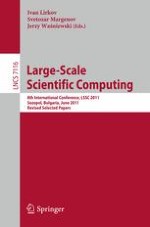This book constitutes the thoroughly refereed post-conference proceedings of the 8th International Conference on Large-Scale Scientific Computations, LSSC 2011, held in Sozopol, Bulgaria, in June 2011. The 74 revised full papers presented together with 3 plenary and invited papers were carefully reviewed and selected from numerous submissions. The papers are organized in topical sections on robust multigrid, multilevel and multiscale, deterministic and stochastic methods for modeling highly heterogeneous media, advanced methods for transport, control and uncertain systems, applications of metaheuristics to large-scale problems, environmental modelling, large scale computing on many-core architectures, multiscale industrial, enviromental and biomedical problems, efficient algorithms of computational geometry, high performance Monte Carlo simulations, voxel based computations and contributed papers.
